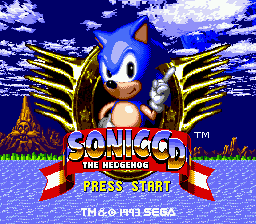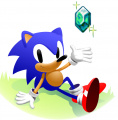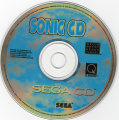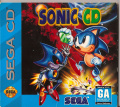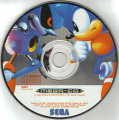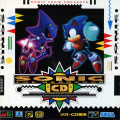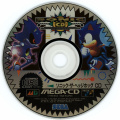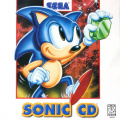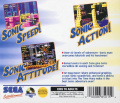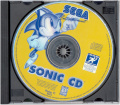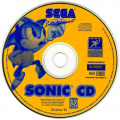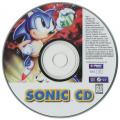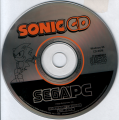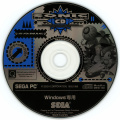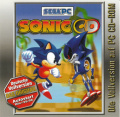Difference between revisions of "Sonic the Hedgehog CD"
From Sonic Retro
MainMemory (talk | contribs) m (→PC release (1996)) |
RGamer2009 (talk | contribs) (→PC release (1996)) |
||
| Line 75: | Line 75: | ||
===PC release (1996)=== | ===PC release (1996)=== | ||
| − | Sonic CD was ported to the IBM PC and released in Japan on August 9, 1996. Following the Japanese release was the North American and European releases, each hitting the market on August 26, 1996 and October 3, 1996 respectively. The PC version featured the entire FMV intro and ending sequences, spanning longer than those of the original Mega CD release. The Japanese version had its manual translated from the US version, and all versions had the US soundtrack, with the "Past" tunes converted to normal Red Book CD audio tracks. Most sound effects in this version were downsampled from the Mega CD original and caused the game to sound weird, (the same applies to the "Gems" edition). Unfortunately, the PC version is not compatible with Windows XP or later without the use of a homebrewed {{file|SonicCDfix.7z|patch}} created by Korama [http://forumsx.sonic-cult.org/index.php?showtopic=6039]. | + | Sonic CD was ported to the IBM PC and released in Japan on August 9, 1996. Following the Japanese release was the North American and European releases, each hitting the market on August 26, 1996 and October 3, 1996 respectively. The PC version featured the entire FMV intro and ending sequences, spanning longer than those of the original Mega CD release. The Japanese version had its manual translated from the US version, and all versions had the US soundtrack, with the "Past" tunes converted to normal Red Book CD audio tracks. Most sound effects in this version were downsampled from the Mega CD original and caused the game to sound weird, (the same applies to the "Gems" edition). Unfortunately, the PC version is not compatible with Windows XP or later without the use of a homebrewed {{file|SonicCDfix.7z|patch}} created by Korama [http://forumsx.sonic-cult.org/index.php?showtopic=6039]. This patch, however will not work with the Dino Version of Sonic CD. |
===''Sonic Gems Collection'' (2005)=== | ===''Sonic Gems Collection'' (2005)=== | ||
Revision as of 02:51, 4 December 2010
| Sonic the Hedgehog CD |
|---|
| System(s): Sega Mega CD, Windows PC |
| Publisher: Sega |
| Developer: Sonic Team |
| Genre: 2D Platform |
Sonic the Hedgehog CD (Japan) or Sonic CD (Europe and North America) is a video game for the Sega Mega CD which is still well acclaimed by Sonic fans. It was the first and only Sonic the Hedgehog game released for the Mega CD. It is one of the few Sonic games of this era in which Yuji Naka played no major role in development; instead, it was handled by Sonic's creator Naoto Ohshima.
Sonic CD was the first Sonic game to offer the player the ability to save their progress, using the internal Mega CD memory or a backup RAM cartridge. The game saves after the end of each Zone's third Act, and records the best times achieved by the player in the time attack mode. This is also the first Sonic game to feature FMV. Extended versions of these FMVs were included in Sonic Jam and Sonic Mega Collection.
Early in the game's development, the gaming press and even Sega's former head of marketing Al Nilsen stated the game was going to be a port of Sonic the Hedgehog 2 and often referred to it as Sonic the Hedgehog 2 CD[1]. It was then decided to release this as a totally new game, and all ideas of ports were scrapped.
Contents
Story
Little Planet is a beautiful and tiny world, where eight special stones called the Time Stones are found. The Time Stones are powerful gems that are capable of controlling the passage of time. The evil Dr. Robotnik had his eye on these stones all along, ever since the planet first appeared above Sonic's home planet, as it now regularly does, on the last month of the year. Upon locating the Little Planet, Robotnik and his robot cronies immediately chained it to the main planet (specifically a mountain with his own face carved into it), then set about converting the planet into a giant fortress. Seeing this, Sonic set off up the chain to investigate. Amy Rose, a female hedgehog, had the idea to find Sonic using tarot cards, and was 'told' that she would have a "destined" encounter with him on the Little Planet. She found him in Palmtree Panic and followed him through this area, but shortly after in Collision Chaos she was kidnapped in front of his eyes by Robotnik's newest robotic creation, Metal Sonic. Sonic must rescue Amy, and collect the Time Stones and travel through time in order to foil Robotnik's latest plot. Sonic accomplishes his mission, and Little Planet quickly vanishes after it is freed.
Gameplay
Rounds and Zones
In most Sonic games, Zones are themed levels, which each comprise several numbered Acts (i.e. stages), and Zone names are often suffixed with the word "Zone" itself. In Sonic CD, however, themed levels are referred to as Rounds (not suffixed with "Zone") and the numbered stages therein are called Zones. The game comprises 8 Rounds:
- Palmtree Panic
- Collision Chaos
- Tidal Tempest
- Quartz Quadrant
- Wacky Workbench
- Stardust Speedway
- Metallic Madness
At the end of each Zone, if Sonic has 50 rings in his possession, behind the Dr. Robotnik signpost will appear a Giant Ring that allows him access to a Special Stage, in which he has the chance to collect one of the eight Time Stones (see linked article or section on time travel below).
It is interesting to note a certain degree of resemblance between the Rounds of Sonic CD and the Zones of its prequel Sonic 1: for example, Palmtree Panic and Green Hill Zone, Collision Chaos and Spring Yard Zone, Tidal Tempest and Labyrinth Zone. Furthermore, much speculation has been given to the deleted level known as R2, and what its theme may have been had it not been scrapped (including suggestions that it would resemble the ruins in the intro movie, a possible link to Marble Zone).
Moves
Sonic's Spin Dash in Sonic CD is different from that of subsequent 2D games, which debuted in the next series game, Sonic the Hedgehog 2 (16-bit); see the former article for more information. A new move was added to complement the Spin Dash: the Super Peel-Out. The Super Peel-Out can be performed by pressing and holding up ![]() , then pressing and holding any trigger button. This causes Sonic to rev up while running in place, until
, then pressing and holding any trigger button. This causes Sonic to rev up while running in place, until ![]() is released, at which point he goes speeding off. The difference difference between the two moves is that the Spin Dash damages enemies who get in Sonic's way, due to his curled attacking pose; while the Super Peel-Out leaves the running Sonic vulnerable to attack, but moving faster.
is released, at which point he goes speeding off. The difference difference between the two moves is that the Spin Dash damages enemies who get in Sonic's way, due to his curled attacking pose; while the Super Peel-Out leaves the running Sonic vulnerable to attack, but moving faster.
Time travel
The game's key element is the concept of time travel. The player can travel to four different versions of each Zone, spanning three different time periods: past, present, and two versions of the future. This is accomplished by passing one of the Past or Future signs that are scattered throughout each level, and then running at top speed until Sonic is sent to that time period, relative to his current one. (Since there are only three time periods, there are never any Past signs in the past or Future signs in the future.)
The different time periods have slightly different layouts and object placements, as well as significant changes in the Round music, art and color palettes. In addition, the badniks within a level fall into a state of disrepair as time passes: In the past, they have seem to have been deployed only recently, as they still function fully; in the present, some have become worn down; while in the future, all have been worn down. This wear can affect the speed and attacking ability of the badniks, with some becoming completely ineffective, while others do not significantly change.
The future of any Zone will be a Bad Future, unless a special robot generating machine is destroyed in the past, or Sonic has collected all of the Time Stones. In these cases, it will be a Good Future, without badniks and other mechanisation. Also hidden within the past of each Zone is a hologram projector showing Metal Sonic squashing an animal with his foot. Destroying this will cause animals to appear in the past and present levels. However the animals are always present in the Good Future, regardless of whether or not the projector has been destroyed.
The third Zone of each level always takes place in the future, and contains a short introductory section then a boss battle with Dr. Robotnik (or, in Stardust Speedway, Metal Sonic). These third Zones will only represent a Good Future if Sonic achieved the Good Future in the previous two Zones.
Bosses

Most boss battles in Sonic CD are more elaborate than those in other Sonic games, and typically require Sonic to hit his enemy fewer times than the usual eight or six. However, the game's boss battles generally require more effort to actually hit Robotnik. One battle takes place on a makeshift pinball table and requires the player to use flippers to get up to Robotnik. Two battles do not involve hitting Robotnik to damage him; one takes place on a giant treadmill where the objective is to wear out Robotnik's machine by running on it, and the other is a race against Metal Sonic.
Versions
International
The soundtrack for international versions of Sonic CD (those published by Sega of Japan and Sega of Europe) was composed by Naofumi Hataya and Masafumi Ogata, and featured songs by Keiko Utoku. The songs were entitled "Sonic - You Can Do Anything" (infamously nicknamed "Toot Toot Sonic Warrior" by Sonic fans) and "Cosmic Eternity".
The boss theme for the international soundtrack uses elements from Bob Marley's "Sun is Shining(Funkstar Remix)", Hall & Oates' "I Can't Go for That(No Can Do)" and "Work That Sucker To Death" by Xavier.
American
Sonic CD was delayed a few months for its North American release to have a new soundtrack composed by Spencer Nilsen, who did other Mega CD soundtracks as well as some early Sega Saturn soundtracks. All the music (save for the Past tunes, which were in PCM audio rather than Red Book CD audio) was replaced, and new themes were composed, each with entirely different rhythms and beats not heard in the international release.
Replacing "Sonic - You Can Do Anything" is a song called "Sonic Boom", performed by Pastiche. Both the opening and ending had similar lyrics but different instrumentation.
Differences
Every re-release of the game in the US exclusively has the American soundtrack, including both the PC version and the one in Sonic Gems Collection (the latter having the American soundtrack even in Europe); the international soundtrack surfaced in Sonic Screensaver, but otherwise has never made it to the States.
The American release also replaced Amy Rose's name in the manual with that of Princess Sally to garner support for the television show, despite the fact that the Princess Sally character was already established.
The race with Metal Sonic plays the default music based on the version of the future being played. The international version always plays the Bad Future theme. The "Little Planet" theme is played in the Time Attack screen in the American version instead of second Title screen track. The ability to re-start the level at the cost of a life was added to the American release and can be performed by pausing the game and pressing either ![]() ,
, ![]() , or
, or ![]() .
.
PC release (1996)
Sonic CD was ported to the IBM PC and released in Japan on August 9, 1996. Following the Japanese release was the North American and European releases, each hitting the market on August 26, 1996 and October 3, 1996 respectively. The PC version featured the entire FMV intro and ending sequences, spanning longer than those of the original Mega CD release. The Japanese version had its manual translated from the US version, and all versions had the US soundtrack, with the "Past" tunes converted to normal Red Book CD audio tracks. Most sound effects in this version were downsampled from the Mega CD original and caused the game to sound weird, (the same applies to the "Gems" edition). Unfortunately, the PC version is not compatible with Windows XP or later without the use of a homebrewed patch (info) (286 kB) created by Korama [2]. This patch, however will not work with the Dino Version of Sonic CD.
Sonic Gems Collection (2005)
A modified version of the PC port was made available as part of the GameCube (and, in Japan and Europe, PS2) compilation Sonic Gems Collection. The Japanese and USA region versions of this port received the same soundtracks as in their original release, but the European release had its soundtrack replaced with the American one. One difference in this version is the water in Tidal Tempest, which is clear instead of green (as is in the Mega CD version.)
A strange fact to notice is that the Debug Mode cheat code is not only listed as a hidden picture, but when the code is enabled, the default feature of placing objects will not work. This is due to the Nintendo GameCube's X button not functioning in-game, for an unknown reason.
Manuals
- Sonic CD US Manual
- Sonic CD US "Not for Resale" Manual
- Sonic CD EU Manual
- Sonic CD JP Manual
- Sonic CD (PC) US Manual
- Sonic CD (PC) EU Manual
- Sonic CD (PC) JP Manual
Also released in
- Sega Family Fun Pak for the PC (1996)
- Sonic & Garfield Pack for the PC (1999)
- Sonic Action Pack for the PC (2000)
- Sonic Action 4 Pack for PC (2001)
- Twin Pack: Sonic CD and Sonic & Knuckles Collection (2002)
- Sega PC Mega Pack for the PC (2003)
- Sonic Gems Collection for the Nintendo GameCube and Sony PlayStation 2 (2005)
Voice actors
| Role | Voice Actor |
|---|---|
| Sonic the Hedgehog | Keiko Utoku[3] |
| Amy Rose | Lynn Harris |
Production credits
Main
Executive Producer: Hayao Nakayama
Producers: Minoru Kanari, Makoto Oshitani
Director: Naoto Oshima
Program Director: Keiichi Yamamoto
Art Director: Hiroyuki Kawaguchi
Sound Director: Yukifumi Makino
Game Designers: Hiroaki Chino, Kenichi Ono, Yuichiro Yokoyama, Takao Miyoshi, Akira Nishino
Character Designer: Kazuyuki Hoshino
Landscape Designers: Hiroyuki Kawaguchi, Takumi Miyake, Masahiro Sanpei, Masato Nishimura, Hideaki Kurata
Special Stage Designers: Kazuyuki Hoshino, Judy Totoya
Special Stage Progammer: Keiichi Yamamoto
Animation Programmers: Yuichiro Mine, Eiji Horita
Animation Visual Directors: Hiroyuki Kawaguchi, Masahiro Sanpei
Visual Design: Kazuyuki Hoshino, Takumi Miyake
Chief Programmer: Matsuhide Mizoguchi
Programmers: Yuichi Matsuoka, Hiroshi Takei, Tatsuya Satoh, Noritaka Yakita
Sound Effects: Yukifumi Makino
Sound Programmer: Yukifumi Makino
Development Support: Al Nilsen
Promoter: Hiroyuki Tanaka
Music (Original/JPN): Naofumi Hataya and Masafumi Ogata
Music (US): Spencer Nilsen, David Young
Animation Staff
Producers: Yasuo Yamaguchi, Mutsumi Kido
Director: Yukio Kaizawa, Ryo Watabe (Being Co. Ltd.)
Art Director: Shinzou Yuki
Chief Key Animator: Hisashi Eguchi (Studio Junio)
Key Animator: Tetsuya Kumagai, Toshiyuki Komaru, Yasuyuki Shimizu, Ichiro Furuichi, Kenji Kajiwara
Camera Director: Masaru Banzai
Production Manager: Kohji Sekiguchi
Assistant Production Manager: Kouichi Hirose
In Cooperation With: Studio Junio
Produced By: Toel Animation Co.Ltd
Recorded At: Birdman Mod Studio
Special Edition for North America
Music Composed and Produced By: Spencer Nilsen, David Young
Vocal By: Sanday Cressman, Jenny Meltzer, Becky West
Drums & Percussion By: Brad Kaiser
Guitars By: Erik Frykman
Recorded and Mixed By: Sega Multmedia Studio(Sega Of America), Intermix
Addtional Music Composed And Produced By: Sterling
Bass: Bobby Vega
Percusion: Armando Peraza
Engineer: Charles Albert
Assistant Engineers: Roosevelt Hoover, Maurice Jackson
Special Thanks: Naofumi Hataya, Masafumi Ogata, Daisuke Saito, Hiroshi Kubota, Reiko Kodama, Yoshiaki Kashima, Takenobu Mitsuyoshi, Masaru Setsumaru, Hifiri Aoki, Stene Ray Burton, James Michael Spahn, Kounosuke Yoshio, Tomoko Sasaki, Aki Kamta, Fujio Minegishi, Jina Ishiwatari, Katsufumi Yoshimori, Tetsuo Akagi, Kaeko Itoh, Hiromi Nakatani, Hiroshi Fukuda, Etsuko Yamada, Ryuichiro Kutsuzawa, Takashi Lwade, Michikazu Tamamura, Masumi Uchida, Tohru Watanuki, Makoto Suzuki, Audix, Digital Support Group, Fairlight E.S.P, Opcode, Otari, Zoom
Resources
Original Sound Version Recordings
For the Windows version see Sonic CD for Windows 95 OST for a download page. For the Japanese Mega CD version see Sonic CD (Japan & PAL Regions) OST.
Artwork
Scans
Mega CD
PC
- Scd-pc-eu-cover.png
EU front cover
Other
| Sonic the Hedgehog CD | |
|---|---|
|
Main page (2011) Manuals |
show;hide
Scrapped Enemies: Scrapped Bosses: Mega-CD: Windows PC:
Books:
Music: |
| Sonic the Hedgehog games for the following systems | |
|---|---|
| |
1991 Sonic the Hedgehog | Sonic Eraser 1992 Sonic the Hedgehog 2 1993 Sonic the Hedgehog CD | Dr. Robotnik's Mean Bean Machine | Sonic Spinball 1994 Sonic the Hedgehog 3 | Sonic & Knuckles 1995 Chaotix | Sonic Classics 1996 Sonic 3D: Flickies' Island |
